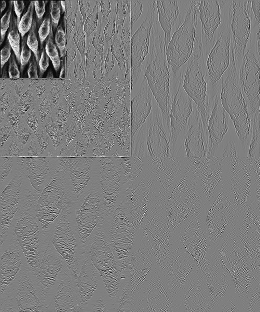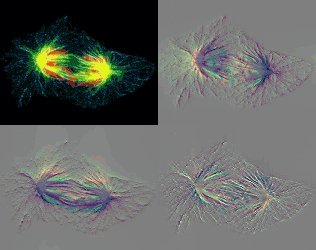
New algorithm of wavelet transform
Gil Gaillard
Micro-engineering
Student Project
Diploma Project, February 2001
Abstract
The Fourier transform gives information about the frequency content of a signal. No frequency information is available in the time-domain signal, and no time information is available in the Fourier transformed signal. The wavelet transform provides the time-frequency representation, with this transform time intervals of spectral components are known.
The keys to the wavelet transform are the lowpass and highpass filters. Since the image is two-dimensional, and the filters are one-dimensional, the filters are applied once in the horizontal direction, and once in the vertical direction. This means that each section of the result image corresponds to one unique combination of horizontal and vertical filters. The upper sections correspond to a lowpass vertical filtering, and the bottom sections correspond to a highpass vertical filtering. The left sections correspond to a lowpass horizontal filtering, whereas the right sections correspond to a highpass horizontal filtering.
Splines are used to calculate filters, these filters can be FIR or IIR. Splines orders define the selectivity in frequency domain and to get more choice about this selectivity an algorithm which implements fractional Splines is necessary.
The innovation of this algorithm is the realisation of a fast and exact wavelet transform for FIR and IIR filters. Such a transform is possible in Fourier domain.
The final form of the algorithm is a plugin implemented in Java for ImageJ, a Java freesoftware which allows everybody to process images. The source code can be integrated in applications such compression and denoising in biomedical images.
Wavelet transform of a grayscale image
causal orthogonal
order=-0.4 2 iterations


Wavelet transform of a RGB image
symmetric orthonormal
order=p/10 1 iteration

